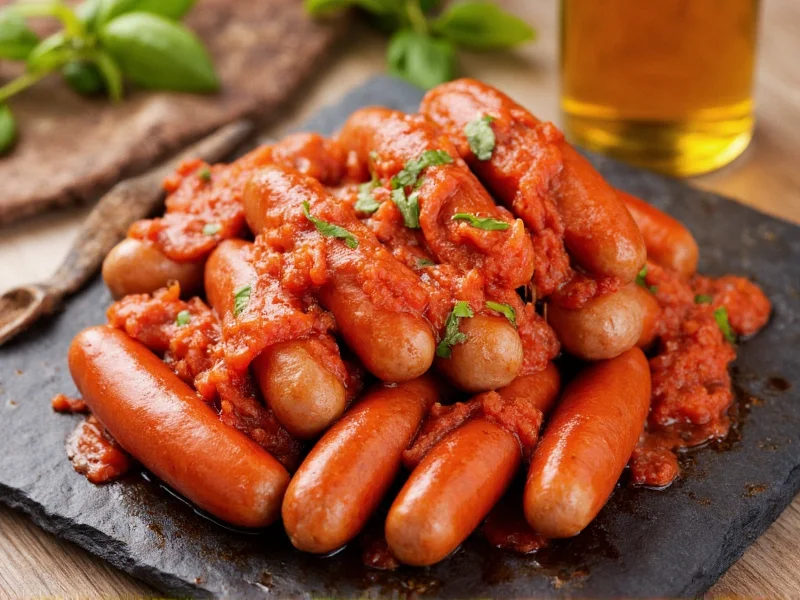Understanding Italian Sausage Links: More Than Just a Sausage
Italian sausage links represent one of America's most beloved meat products, yet many home cooks don't fully understand what makes them unique. These connected pork sausages differ significantly from breakfast sausage or bratwurst through their distinctive seasoning profile and preparation method. The characteristic flavor comes primarily from fennel seeds, which provide that unmistakable licorice-like note, combined with garlic, black pepper, and sometimes wine or cheese.
Key Characteristics of Authentic Italian Sausage Links
What separates genuine Italian sausage links from imitations? Several defining features create the authentic experience:
- Meat composition: Traditionally made with 70-80% lean pork shoulder
- Seasoning blend: Fennel seed is non-negotiable, plus garlic, salt, black pepper
- Texture: Coarsely ground for that satisfying bite
- Form: Natural casing creates the "snap" when cooked properly
- Varieties: Mild (no red pepper) versus hot (with crushed red pepper)
Mild vs Hot Italian Sausage Links: What's the Difference?
The primary distinction between mild and hot Italian sausage links lies in the spice profile. Mild varieties contain the classic fennel and garlic blend without any heat elements. Hot Italian sausage includes crushed red pepper flakes, typically ranging from 1-2% by weight. Contrary to popular belief, hot Italian sausage isn't comparable to spicy chorizo—it delivers a subtle warmth rather than intense heat. When shopping for Italian sausage links near me, check the ingredient list for the red pepper content to gauge heat level.
| Characteristic | Mild Italian Sausage | Hot Italian Sausage |
|---|---|---|
| Primary Seasonings | Fennel, garlic, black pepper | Fennel, garlic, red pepper flakes |
| Heat Level | None | Mild to medium (not extreme) |
| Traditional Uses | Pasta dishes, sandwiches | Pizza toppings, hearty sauces |
| Visual Identification | No red specks visible | Red pepper flakes visible |
How Italian Sausage Links Differ From Other Sausage Types
Many consumers confuse Italian sausage links with other varieties. Breakfast sausage lacks fennel and uses different herbs like sage. Sweet Italian sausage is actually the same as mild Italian sausage—"sweet" refers to the absence of heat, not sugar content. Andouille sausage features smoked paprika and cayenne, while bratwurst uses nutmeg and ginger. When preparing Italian sausage links for pizza or pasta, understanding these differences ensures proper flavor pairing.
Perfect Cooking Methods for Italian Sausage Links
Mastering how to cook Italian sausage links properly preserves their juiciness while developing flavor. The best approach combines gentle cooking with proper temperature control:
- Refrigerated thawing: Never microwave—thaw overnight in refrigerator
- Pricking: Lightly prick casings with fork to prevent bursting
- Par-cooking: Simmer in water or broth for 10-12 minutes before finishing
- Finishing methods: Grill, pan-sear, or broil for caramelization
- Temperature check: Always verify 160°F internal temperature
For the best way to grill Italian sausage links, maintain medium heat (350-375°F) and rotate frequently. When cooking Italian sausage links in the oven, 400°F for 20-25 minutes yields excellent results. Never pierce excessively during cooking, as this releases precious juices.
Storage and Handling Guidelines
Proper storage extends the shelf life of Italian sausage links while maintaining food safety. Unopened packages last 1-2 days in the refrigerator past the sell-by date. For longer storage, freeze Italian sausage links using these methods:
- Vacuum-seal for up to 3 months
- Wrap tightly in freezer paper with minimal air exposure
- Portion into meal-sized quantities before freezing
- Thaw overnight in refrigerator—never at room temperature
When purchasing Italian sausage links in bulk, check for firm texture and avoid packages with excessive liquid or discoloration. Fresh Italian sausage should have a pinkish hue with visible fat marbling.
Culinary Applications and Recipe Inspiration
Italian sausage links offer remarkable versatility beyond simple grilling. Consider these creative uses:
- Pasta integration: Remove casing and crumble into tomato sauces
- Breakfast options: Slice and pair with eggs and peppers
- Pizza topping: Thinly slice after par-cooking for even cooking
- Stuffed vegetables: Mix with breadcrumbs for pepper or mushroom stuffing
- Soup enhancement: Add sliced links to bean or vegetable soups
For authentic Italian sausage links recipes, traditional preparations include pasta e fagioli with sausage, sausage and broccoli rabe sandwiches, and sausage-stuffed artichokes. When substituting Italian sausage links for patties in recipes, account for the casing by removing it before crumbling.
Nutritional Profile and Dietary Considerations
A standard 3-ounce serving of cooked Italian sausage links contains approximately:
- 290-320 calories
- 25-28g fat (including 9g saturated fat)
- 15-18g protein
- 600-700mg sodium
- Negligible carbohydrates
While not considered a health food, Italian sausage links provide substantial protein and certain B vitamins. For lower-fat options, look for varieties made with turkey or chicken, though these differ significantly in flavor profile from traditional pork versions. When preparing Italian sausage links for family meals, balance with vegetable-rich sides to create a more nutritionally complete dish.











 浙公网安备
33010002000092号
浙公网安备
33010002000092号 浙B2-20120091-4
浙B2-20120091-4